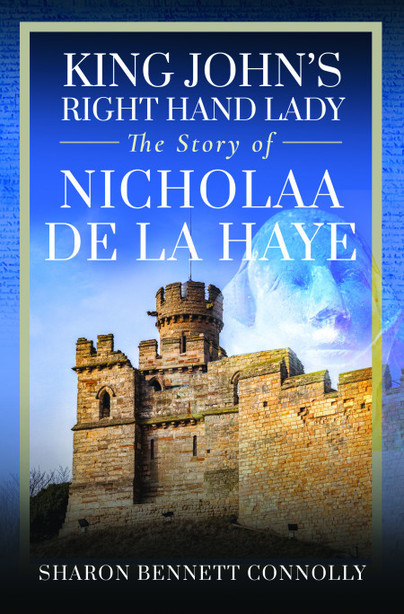Women’s History Month – Sharon Bennett Connolly
How to defend a castle the Nicholaa de la Haye way
How do you defend a castle?
Well, in Nicholaa de la Haye’s case, you do it ‘manfully’. That’s not because Nicholaa was a man, nor because there was a particular way in which men defended castles. Rather it was because the chroniclers had no way of expressing how impressed they were with Nicholaa de la Haye’s defence of Lincoln Castle, other than to say that she acted ‘like a man’.
Chroniclers in those days were not in the habit of writing about women, especially when it came to warfare.
But Nicholaa was well practised in defending her castle.

Siege no. 1
Nicholaa first comes to the attention of the chroniclers in 1191, when Prince John led the opposition to his brother’s chancellor, William Longchamp. Longchamp demanded the fealty of Nicholaa’s husband, Gerard de Camville. And when Gerard refused, Longchamp ordered that Gerard de Camville relinquish Lincoln Castle to one of his own supporters. Gerard refused, and swore fealty to John, joining him at Nottingham Castle. Leaving Nicholaa to hold Lincoln. Richard I’s Chancellor, William Longchamp, headed north and laid siege to Lincoln Castle.
The formidable Nicholaa refused to yield, holding out for 40 days before Longchamp raised the siege, having achieved nothing, and went home. Worse still, the castles at Tickhill and Nottingham fell to John. Amusingly, Richard of Devizes said of Nicholaa’s defence of Lincoln Castle, that she did it ‘without thinking of anything womanly’.
Unfortunately, Nicholaa and Gerard would pay dearly for holding onto their castle. When Richard the Lionheart returned from Crusade in 1194, Camville was stripped of his positions as Sheriff of Lincolnshire and Castellan of the castle and fined heavily. The castle was only having it returned to Nicholaa and Gerard on the accession of King John in 1199.
As we all know, King John’s reign wasn’t exactly smooth sailing. He lost his French lands and was held to account by the barons of England for numerous examples of maladministration, corruption and outright murder. In 1215 he had been forced to seal the Great Charter, or Magna Carta, in order to avoid war.

But war broke out anyway.
Gerard de Camville died around 1215 and, although now a widow, it seems the castle remained in Nicholaa’s hands. Gerard de Camville had died around 1215 and, although now a widow, it seems the castle remained in Nicholaa’s hands. On one of King John’s visits to inspect the castle’s defences in 1216, there was a rather dramatic display of fealty from Nicholaa. Nicholaa met John at the castle gates, keys in hand, claiming she was too old and tired to remain as castellan. John returned the keys and insisted that Nicholaa continue to hold the castle until her ordered otherwise.
Whether Nicholaa ever intended to give up Lincoln, or the event was staged so that John could demonstrate his continued trust in Nicholaa, is open to debate. I suspect it was the latter. John was in the midst of civil war and running short of allies. Nicholaa had already demonstrated her abilities at defending Lincoln, and her loyalty to John – he would have been hard put to replace her. However, the event gave John the opportunity to reinforce his trust in Nicholaa in front of his barons.
Siege no. 2
The rebel barons now invited the king of France to take the throne of England; instead, Philip II’s son, Louis (the future Louis VIII), accepted the offer and was hailed as King of England in London in June 1216. In the same year Nicholaa prevented another siege by paying off a rebel army, led by Gilbert de Gant, who remained in occupation of the city of Lincoln but lifted the siege of the castle. After Nicholaa paid off the 1216 besiegers, John came north, and he chased the rebels into the Isle of Axholme ‘with fire and sword’.

Siege no. 3
John died, little mourned, on the night of 18/19 October 1216. As soon as John was out of the way, Gilbert de Gant renewed the siege of Lincoln Castle, receiving reinforcements from Louis’ forces, under the Comte de Perche, in early 1217. Now in her 60s Nicholaa de la Haye took charge of the defences.
When the small rebel force proved insufficient to force a surrender, the French had to send for reinforcements and siege engines. For almost 7 months, Nicholaa was besieged, with the circle tightening from March to mid-May as siege machinery bombarded the south and east walls of the castle. On the 20th May William Marshal arrived with a relieving force. Attacking from the north of Lincoln, his army proceeded to attack the besieging forces and, after about 6 hours of fighting, routed the enemy; the French commander, the Comte de Perche, was killed in the fighting, and the rebel leaders captured.
In a magnificent demonstration of ingratitude, within 4 days of the relief of the Castle, Nicholaa’s position of Sheriff of Lincolnshire was given to the king’s uncle William Longspée, Earl of Salisbury, who took control of the city and seized the castle.
Not one to give up easily Nicholaa travelled to court to remind the king’s regents of her services, and request her rights be restored to her. A compromise was reached whereby Salisbury remained as Sheriff of the County, while Nicholaa held the city and the castle. The settlement was not ideal, however, and Salisbury continued to try to get his hands on the castle, by fair means or foul, until his death in 1226.
Nicholaa had the last word: she finally retired as castellan of Lincoln Castle three months after Salisbury’s death, determined not to give her rival the satisfaction of holding HER castle.

……………………………………………..

King John’s Right Hand Lady is available to order here.

View all books by Sharon Bennett Connolly here.

